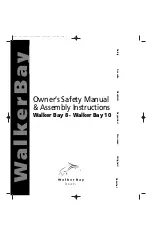
Inha Works Ltd. 2009
2 (31)
PREFACE
Dear Buster owner! Thank you for choosing a Finnish Buster boat and we hope you
will have many enjoyable experiences on board.
This handbook aims to help you use your boat safely and with peace of mind. It
includes details of the boat itself, the equipment and systems installed in it, and
information about how to operate and maintain it. Before you start using your boat,
we urge you to first familiarise yourself with it by reading this handbook thoroughly.
Naturally, the Owner's Handbook cannot provide you with seamanship skills or
information on boating safely. If the Buster is your first boat, or you have changed to
a type of boat with which you are unfamiliar, for the sake of your comfort and safety,
please acquire sufficient handling and operating experience before you take on the
responsibility of command. The seller of the boat, a boat club, or national motorboat
and yachting associations will gladly tell you about local boating schools or
recommend competent teachers.
Before taking out your boat, ensure that its design category is appropriate for the pre-
vailing wind and sea conditions and that you and your crew are capable of handling it
in the existing conditions. The wind conditions and swells in which design category C
can be used include gales and heavy winds, which come with an exceptional risk of
high waves and gusts. Only a competent and fit crew can satisfactorily handle such
dangerous conditions, and can do so only in a well-maintained boat.
This Owner's Handbook is not a detailed guide to maintenance or fault diagnosis. If a
problem occurs, please contact your nearest Buster dealer. If repairs are needed,
use only those businesses recommended by a Buster dealership. Alterations that
affect the safety characteristics of a Buster boat can be carried out only with the
written approval of the manufacturer, who cannot be held responsible for changes to
the boat that it has not approved.
In some countries driving a boat requires a licence or some other similar
authorisation.
Always maintain your boat in good condition and bear in mind the consequences of
wear resulting from ageing, rough treatment and improper use. Any boat, no matter
how strong, can be significantly damaged by improper use. Always adapt the speed
and course of your boat in relation to the conditions at sea.
If your boat is equipped with a life-raft, read its operating instructions thoroughly. The
boat should have on-board safety equipment (life-jackets, safety harnesses, etc.)
appropriate to the boat type, weather conditions, etc. In some countries such
equipment is mandatory. The crew must be familiar with the operations of all safety
equipment and emergency manoeuvres (rescuing a man overboard, towing, etc.).
Rescue exercises are regularly organised by boating schools and clubs.
Every person on board should use an appropriate flotation aid (such as a life-jacket
or vest). Note that in some countries the law requires flotation aids to be used at all
times while on board.
Summary of Contents for L
Page 29: ......



































